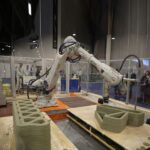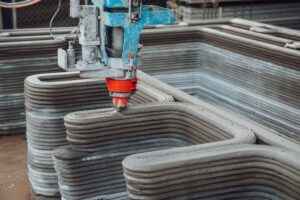Why 3D Construction Printer Manufacturers Need RFID Integration
- Poor Material Management: Improper selection of concrete mix or expired materials can lead to structural defects.
- Quality Control Gaps: Undetected printing errors (Örneğin., misaligned layers) can cause project delays.
- Compliance Risks: Manual record keeping does not meet ASTM/ISO standards for material traceability.
- Equipment downtime: Missed maintenance schedules can result in costly production interruptions.
RFID solutions address these challenges by:
1.Material tracking and waste reduction
Issue: Manually documenting concrete batches results in expired or mismatched materials.
RFID solution:
- Tag raw material containers (Örneğin., cement, aggregate) with UHF RFID tags.
- The printer scans the tags to verify the batch ID and expiration date, and automatically rejects invalid materials.
2.Real-time quality control
Issue: Layer shift or bubbles cannot be detected until post-print inspection.
RFID solution:
- Embed sensor-enabled RFID tagsin the print nozzle to monitor pressure and temperature.
- With PLC integration (Örneğin., Siemens S7-1500), abnormal alarms (Örneğin., nozzle blockage) can be triggered.
3.Compliance and audit readiness
Issue: Paper records delay compliance with ASTM E2919 material traceability requirements.
RFID Çözümü:
- Store mix design, cure time, and operator ID on high-memory RFID tags.
- Sync data to BIM platforms (Örneğin., Autodesk Revit) for automated audit trails.
4.Predictive Maintenance for Printers
Issue: Sudden failure of extruder motor shuts down project for days.
RFID Çözümü:
- Attach vibration-resistant RFID tags to critical components.
- Monitor wear data and schedule maintenance with IBM Maximo integration.
How RFID-3D Construction Printing Integration Works
Tag Placement:
- Material Container: Encode batch data using RFID tags.
- Printer Assembly: Attach Impinj Monza R6 tags to nozzle or extruder.
Veri Akışı:
- RFID reader on printer scans tags during material loading and printing.
- Data Syncs to cloud platform (Örneğin., Trimble Connect) for real-time analysis.
Key Results:
- Reduce material waste by 25-40%.
- Report compliance 50% faster.
- Reduce unplanned downtime by 30%.
Rekabet Avantajınız:
Help your customers achieve precision construction by offering smart, IoT-enabled 3D printers with built-in RFID.
 Ready to upgrade your 3D printing system?
Ready to upgrade your 3D printing system?
We offer scalable RFID solutions tailored for 3D construction printing. Bize ulaşın:
- Test RFID tags for free: Validate their performance in your printing equipment operation.
- Access the Integration Guide: Compatible with COBOD, Apis Cor, and ICON systems.
- Get a customized ROI analysis: Learn how RFID can reduce costs and improve compliance.
[Schedule a Free Consultation]
Sıkça Sorulan Sorular
Q: Can RFID tags withstand the high temperatures of concrete curing?
A: Evet! RFID tags can withstand temperatures up to 85°C, making them ideal for curing areas.
Q: How can I retrofit RFID into my existing 3D construction printer?
Answer: Choose different labels according to different needs, and self-adhesive labels are commonly used.







